This is a simple
kit from Emhar. It is consists of only 22 pieces but it is a nice
kit nonetheless. The plastic is a bit on the soft side but working
with it is fine and it does accept liquid glue very well. Instructions
are straightforward and there are no major vices to this kit. Only
sanding of the mating surfaces was needed to get parts to align correctly
and minimize gaps.
You could build this one straight from
the box and have a nice representation of the Whippet, but with a
little extra work to add some details, you can make this kit really
stand out.
I didn’t like how the machine
guns (parts 16 & 20) mounted, so I backed the holes from the inside
with some sheet plastic. Then the side and rear guns (part 20) were
modified to remove the ball shaped protuberance and the front gun
(part 16) had the rear half of the ball cut off. This allowed me to
attach all of the guns after the painting was complete.
I built the Whippet in three sub-assemblies:
left track assembly, right track assembly and the body.
To keep track of the improvements I
wished to make I created a diagram of my desired changes to ensure
that none were forgotten. Most of these details were easily fashioned
from some plastic strip or rod, so I’ll not give details on
the modifications unless they require a bit more explanation.
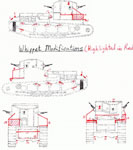
1. Added the missing vertical bracket
behind front fender hangers.
2. Cut off and repositioned front fender hangers. These are reversed
on the base kit.
3. Added missing brace plate to front of tracks just below the tensioner
bolt.
4. Added return rollers to underside of each set of tracks. You’d
be hard pressed to see them but they are
there.
5. Added horizontal support braces in front of return rollers.
7. Added an extra track spud hanger rail below left machine gun with
some thin plastic strip.
6. Replaced the exhaust pipes with sections of plastic coated wire.
This was new trick I tried that worked
quite well but still needs a bit more practice on my part. I cut a
piece of plastic insulated wire to length.
Then I stripped some of the plastic from one end to expose the copper
wire inside. I then grabbed the
copper wire with some pliers and pulled it out a bit so that the other
end of the wire was now just a
hollow tube. Then I cut off some of the copper wire and glued the
new exhaust pipe into a pre-drilled
hole, with the copper wire end inserted into the hole.
8 & 9. Added the missing driver’s and left gunner’s
vision slots. This is the only real omission on the base
kit and it’s quite puzzling as to how they could have been missed
in the first place.
10 & 18. Boxed in the compartment located above rear tow ring
(part 5) plus an extra track spud hanger rail
to the outside of the compartment
11 & 13. Added triangular braces to the four corners of the lower
body where they meet the track
assemblies.
12 & 14: Added front and rear tow rings. These are small triangular
pieces that I cut from plastic sheet
and drilled out a hole for the tow hook.
15. Thinned the curved panel at the rear
16 & 17. Added left storage bin and framing and the framing for
right storage bin, but not the bin itself.
These bins were featured on Whippets later in the war. Some time in
the future I plan is to add some
tarps and/or tools to the left bin to just fill it out a bit instead
of having that gaping empty space.
19. Added the missing drip rail to top front of cabin below the front
gun.
20. Added pistol port to cabin roof
The decal sheet contains markings for
no fewer than eight Whippets.
1. A347 “Firefly”
2. A259 “Caesar II”
3. A378 “Golikell”
4. A230 “Gofasta”
5. A351 “Fanny Adams”
6. A371 “Sphinx” [Sfinksya] in White Russian markings
7. Japanese Whippet #201
8. German captured Whippet
All of the above are in overall green
camouflage except the captured version which has German
multi-coloured camouflage applied.
The decal sheet is excellent. The images
settled down beautifully after a good soaking in Microsol. The white
decals are opaque enough that the underlying dark camouflage doesn’t
show through and darken them. The white/red/white identification bands
are supplied on the sheet but I chose to paint these instead.
I chose the markings for Whippet number
A259, which is the Whippet of Victoria Cross recipient Lt. Cecil Sewell.
Below is the citation from Wikipedia on his actions with Whippet A259.
“Cecil Harold Sewell VC (27 January
1895-29 August 1918) was an English recipient of the Victoria Cross,
the highest and most prestigious award for gallantry in the face of
the enemy that can be awarded to British and Commonwealth forces.
He was educated at Dulwich College between 1907 and 1910.
He was 23 years old, and a Lieutenant
in the Queen's Own Royal West Kent Regiment, British Army, attached
to 3rd (Light) Battalion, Tank Corps during the First World War when
the following deed took place for which he was awarded the VC.
On 29 August 1918 at Fremicourt, France,
Lieutenant Sewell, who was in command of a section of Whippet light
tanks, got out of his own tank and crossed open ground under heavy
machine-gun fire to rescue the crew of another Whippet of his section
which had side-slipped into a shell-hole, overturned and caught fire.
The door of the tank had become jammed against the side of the shell-hole,
but Lieutenant Sewell, unaided, dug away the entrance to the door
and released the crew.”
Not mentioned in the Wikipedia article
is the fact that in his attempt to return to his own tank, Lt. Sewell
was struck by enemy fire and later succumbed to his wounds.
Once all the sub-assemblies were finished
it was on to painting. In this regard I'm a dinosaur in these modern
times - I still use enamels almost exclusively. Because of this I
have to go slow during the painting and washing so that I don't damage
the underlying layers too much. Painting was a multi-step process
as follows:
1. After a coat of light grey Testors
enamel paint as a primer, I applied an overall coat of Testors #1787
Green Drab
2. Next the interior of the panels were sprayed in a cloud pattern
with Aeromaster #9201 French Khaki
3. After a day for drying a coat of Testors Glosscote was applied
and left to dry a couple more days, after which the decals were applied
4. Then a pin wash of Testors Flat Black in paint thinner was applied
to the seams and other places and also on the sides of the track units
to hopefully replicate oil/grease runs. Flat black was also sprayed
on the tracks after masking to prevent over spray onto adjacent panels.
5. All the edges on the body received a brush application of Testors
#1711 Olive Drab thinned with paint thinner. Then the kit was left
to dry another day.
6. The final weathering was a dry brushing of Aeromaster #9094 Earth
Brown overall, keeping most of it to the lower third of the tank.
Then I took some of this same paint, thinned it to a water like consistency,
and airbrushed a light coat on the model, again keeping in and around
the lower third of the tank and also concentrating on the tracks to
give them a dirty/dusty look.
7. The last touch was to add some vertical streaking to the body panels
with some olive drab and khaki paint and to the front of the track
assemblies with brown and black paint.
8. Finally after a couple more days to dry, the final coat of Aeromaster
Acrylic Flat was sprayed to give a nice uniform flat sheen to the
model.
Following the painting all that was
needed to finish the build was the gluing of the sub-assemblies together.
So, if you want an easy and fun kit
to build, then locate one of these and have a go. Straight from the
box it makes into a nice little kit, but with a little extra effort
it can be made into a standout.
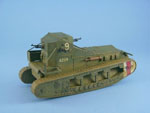 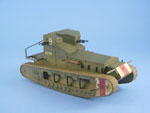 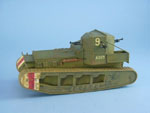 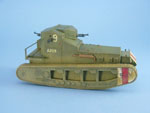
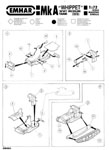
Review sample purchased by the author.
|